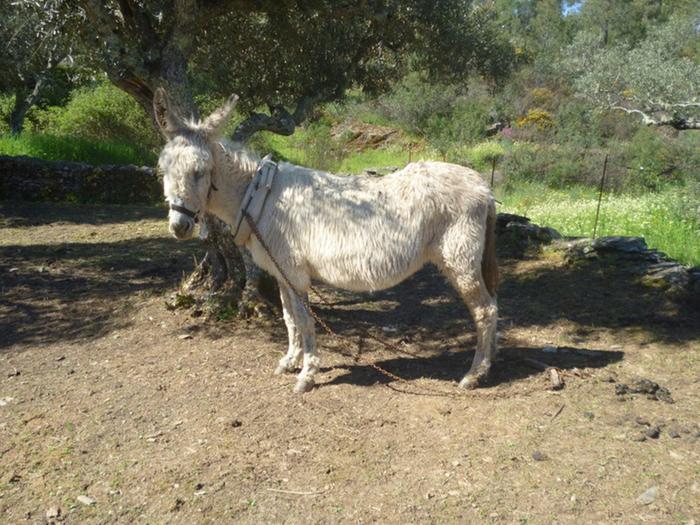Of course, the first problem we hit with the experiment was deciding what to do. My other half tends to want to do things that I'd rather he didn't, and, as my health is iffy and it's him that tends to end up doing all the work, I can only put my foot down so hard and compromises have to be reached.
The first compromise was on clearing the land ready for planting. He wanted to plough the whole lot up to 'clean' it and then plant a patch of veggies to see how they coped compared to the rest of the farm. I didn't want him to plough up any of it, but we eventually compromised so that he could plough up the veggie patch and I would clear all the grass right down to bare earth to keep the neighbours happy and reduce the weeds. Here's my trusty steed having finished the weed clear-up operation and getting ready to haul a bit of timber before being moved back up to the farm. She also left behind a nice supply of manure for putting on the veggie patch.

This was the experimental patch. We tried to choose a nice level place, not too close to the olive trees in case the veggies didn't mix with them, but making use of their shade. We have terrific problems on the rest of our land as there is no shade and no soil worth speaking of and it's exceptionally difficult to keep things alive, let alone growing, during Portugal's crazy hot, dry summers.

My other half soon got busy planting lettuces, cabbages, chard, beetroot...

...and beans. No garden is complete without beans. We agreed not to use any toxic gick of any kind, and I managed to persuade him that mulch was compulsory.

The wells in Portugal are amazing. They are so wide that sunlight gets in and there is generally a good supply of green pond-weed stuff clogging them up and providing food and habitat for critters.

It's also a fairly easy job to throw a hook in and haul some of it out!

There - a nice big bucket full of green mulch. Those cabbage transplants had got a bit pot-bound and are going to need all the help they can get!

If there are such things as mermaids, I'm sure that's what their hair would be like...

Someone's enjoying themselves - he looks like an overgrown cabbage-patch kid. We noticed very early on that although the soil isn't super-fertile, it's certainly a whole load more fertile than any other soil we have. Also, it's deeper and holds water better so that we only had to water once a week, which, in Portugal, is pretty amazing!
Also, as you can see, despite donkey's best efforts at clearing all the grass and 'weeds', they made a determined effort to return. After all, they have been growing here relatively undisturbed for goodness knows how long, and they are surrounded by a patch of very well functioning near-natural ecosystem. It's going to take some determined effort to stop them, and I had no intention of trying. It turned out that I'm very glad we didn't.

They say that if you plant enough variety, then beneficial insects will move in. In this case, they were already here in a vengeance! The moment we picked a leaf, or bruised one, hoverflies and other critters would turn up to take advantage of whatever critters they assumed were causing the damage. My other half has been gardening for decades and although he kind of knew in theory about beneficial insects, he was gobsmacked at the way we would be surrounded by them every time we tried to do anything with 'their' plants. He's now as convinced as I am that using toxins to control 'bugs' is a seriously bad idea.

Here's a few photos I took last autumn.
Some olives, not quite ripe.

A jarrahdale pumpkin.

Ruby chard.

Beetroot.

Galega cabbage and chard.

And a basket of goodies, including a few scrumped quince. Complete with hoverfly.

Overall we were very impressed and decided to gradually turn it into a forest garden, and to keep a veggie patch down there for growing 'pure bred' pumpkins that I don't want to interbreed with the selection we keep on the main farm, and a few beans and cabbages and things to keep the pantry stocked up. And also to keep it as pure and fully functioning as a complete ecosystem as possible.
That's as far as we got last year. This spring we had more experiments to do!

 5
5


















 2
2













 3
3




















 2
2




 2
2



























.jpg)



